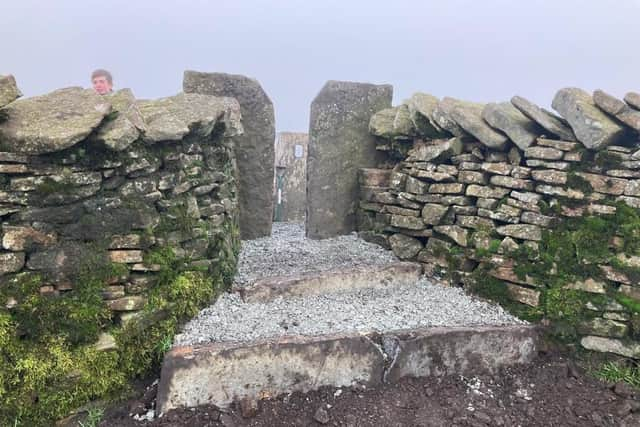The Yorkshire Vet, Julian Norton turns Ranger as he helps with repairs to stone stile on the highest point in Yorkshire


This was not a huge surprise for me, because I’ve spent a lot of time on the top of the highest point in Yorkshire over the years.
736 metres above sea level doesn’t sound massive, but it’s high enough to put you in the clouds and at least five degrees colder than the valley bottom. Add in the increased wind speed, it makes the top of Whernside somewhere that most people stop only for as long as the flask of tea remains warm.
Advertisement
Hide AdAdvertisement
Hide AdThe plan that lay before me involved several hours of work, one park ranger called Ian, two assistants, some spades and pick axes, slabs of rock and bags of aggregate. Oh, and two people holding cameras, both of which were pointing at Ranger Ian and me.


There was a stone stile that needed to be mended, right on the border between Cumbria and Yorkshire.
I’d been invited along to help and get an insight into the work of a Yorkshire Dales ranger. Once again, as well as getting busy with a spade, I was acting as a “presenter” and as far outside any zone resembling comfort that you could imagine.
The first job was to the top. The last time I’d done this, I was wearing lycra running leggings and running shoes with huge nobbles underneath, competing in the Three Peaks Race. It was some years ago and was muddy and sweaty.
Advertisement
Hide AdAdvertisement
Hide AdToday’s ascent was less strenuous but no less arduous. We clambered into a buggy with newly applied caterpillar tracks, so it felt just like a tank. Picking the route and avoiding the bogs was similar to running up the hill in the race.
I hoped Ian knew the way because I had, on occasions, ended up knee-deep in bog having been tricked by the surface conditions. Even with caterpillar tracks, I could picture us sinking, never to be discovered.
Ranger Ian’s route proved sensible and safe and we eventually arrived at the top. Ian explained the plan and I grabbed a spade. The cameras started to roll as we began to dig. A reinforced step, on each side of the gap-style, needed to be made.
The ground had eroded, making it hard for anyone who wasn’t slim-line to squeeze through the gap. It was hard work but an excellent way to keep warm. The poor camera operators weren’t having such a good time.
Advertisement
Hide AdAdvertisement
Hide AdEven with a heavy device on your shoulder, it was hard to stay warm, but they fastidiously captured all the action, only occasionally disrupting the important work with (sometimes) relevant questions.
As we dug out the new and improved step, I quizzed Ranger Ian on his work and why it was important. Bizarrely, he was the sole employed ranger in the Three Peaks National Park. Fences, gates, stiles and paths needed constant repair, to enable people to enjoy Yorkshire’s wild open spaces while keeping the infrastructure in a decent state.
He explained his love for Yorkshire and its wilderness; the cameras zoomed in on his face to capture his passion and enthusiasm, then panned out to get a shot of Ribblehead viaduct in gaps in the cloud.
I asked questions where necessary, but most were redundant because Ian was so eloquent. Before long, the early start, hard digging and cold weather made us all hungry, so we sought shelter in the back of the caterpillar truck.
Advertisement
Hide AdAdvertisement
Hide AdAs I looked for our packed lunches, I couldn’t help but ask Park Ranger Ian if he’d seen the pic-a-nic baskets.
Outside of Jellystone and inside a cold, Yorkshire cloud, apparently this wasn’t a particularly funny joke.